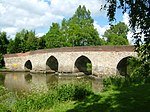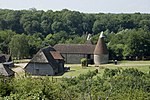Allington Castle

Allington Castle is a stone castle in Allington, Kent, just north of Maidstone, in England. The first castle on the site was an unauthorised fortification, built during "The Anarchy" (1135–1153) and torn down later in the century when royal control was reasserted. It was replaced by a manor house, which was fortified with royal permission in the 13th century. Various alterations and expansions were made by successive owners over the following two centuries. The property was developed into a fortified compound with six towers at irregular intervals along the curtain wall and domestic buildings in the interior, including one of the first long galleries built in England. In 1554 it was seized by the Crown in the course of dispossessing its owner, Sir Thomas Wyatt the Younger, after the failure of his rebellion against Queen Mary. The castle entered a state of decay that was accelerated by fires, neglect and vandalism, until it was largely ruined by the start of the 20th century. It was saved and restored by the efforts of Sir Martin Conway and his wife during the first half of the century. After nearly 50 years of occupation by a community of Carmelite friars and nuns, it returned to being a private residence in 1999 and is currently the home of Sir Robert Worcester, the founder of the MORI polling company. It is a grade I listed building and is used as a wedding venue, though there is no public access other than occasional tours involving trips from Maidstone town centre on the Kentish Lady river boat.
Excerpt from the Wikipedia article Allington Castle (License: CC BY-SA 3.0, Authors, Images).Allington Castle
A229 to River Medway,
Geographical coordinates (GPS) Address External links Nearby Places Show on map
Geographical coordinates (GPS)
| Latitude | Longitude |
|---|---|
| N 51.293333333333 ° | E 0.51166666666667 ° |
Address
Allington Castle
A229 to River Medway
ME14 2BY , Ringlestone
England, United Kingdom
Open on Google Maps








